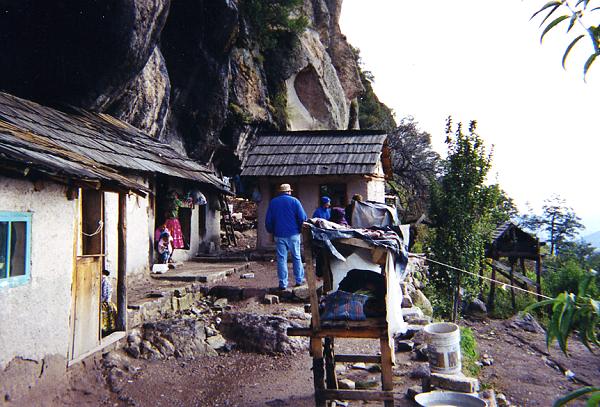A cave dwelling known as “Cueva del Chino” is located a short distance from the Posada Barrancas railway halt, very close to the present-day location of the Posada Barrancas Mirador hotel. When I first visited this cave, in the mid-1980s, I was struck by the obvious dangers of living so close to a precipitous drop. The cave is on a very narrow ledge, some 20 meters or so below the canyon rim. There is a local spring which acts as a water supply, though it is perhaps not always a reliable year-round supply. Outside the cave is a tangle of vegetation, much greener and more varied than elsewhere along the canyon wall. It was only on my second or third visit to this cave that I realized that this unruly vegetation was not only due to the nearby natural water source, but also due to the assiduous work of the cave’s residents. The tangled vegetation was actually a very productive garden, offering a variety of vegetables, fruit and herbs.
Accustomed, as most of us are, to the idea of crops and plants in neat orderly rows, the mini-jungle in the cave’s small garden-farm may come as a surprise. But there are sound ecological (and economic) advantages to maintaining, and even encouraging, this apparent disorder. Among the major advantages of mixed cropping (sowing several different crops more or less at random in an area) are the following:
- (a) some plants are perennial, others annual; hence a ground-cover is maintained all year and the likelihood of soil erosion is diminished
- (b) taller plants provide shade for shorter plants, offering distinct microclimates within the garden
- (c) some plants (legumes) help fix nitrogen in the soil; other plants need the nitrogen
- (d) a variety of plants means a much more varied diet
- (e) since different crops use different nutrients, the total yield off a small plot is greater with a mix of crops than with a single crop
- (f) if disease or insects strike one plant, they may not be able to spread to the next plant of that kind
- (g) if one crop fails for any reason, another may succeed; this may be enough to ward off starvation for another year
- (h) in terms of energy efficiency, this is a very efficient system, since it involves relatively little labor; the output of energy will exceed the input (see The energy efficiency of farming in Mexico and elsewhere for more details)
Put simply, who really wants to work harder than necessary?
The photos show the truly astonishing changes that took place in this cave dwelling and garden between 1989 and 2003. The major change in the area between those years was the construction of the Posada Barrancas Mirador, only a few steps away from the path leading down to the cave. This has led to a steady trickle of visitors who buy the locally-made pine needle basketwork (top photo) or leave behind a few pesos.Are these changes really for the better? There are arguments on both sides, and I’m honestly not entirely sure. I haven’t been back for several years, but would welcome an update (and photo) from any Geo-Mexico reader who happens to visit.
Related posts:
- The seven main canyons in the Copper Canyon region
- How were the canyons in the Copper Canyon region formed?
- The settlement patterns of the Tarahumara in Mexico’s Copper Canyon region
- Tarahumara agriculture in the Copper Canyon region
- The diet and tesgüinadas of the Tarahumara Indians in the Copper Canyon region of Mexico
- Mexico’s Copper Canyon train is one of the world’s great railway trips


Sorry, the comment form is closed at this time.